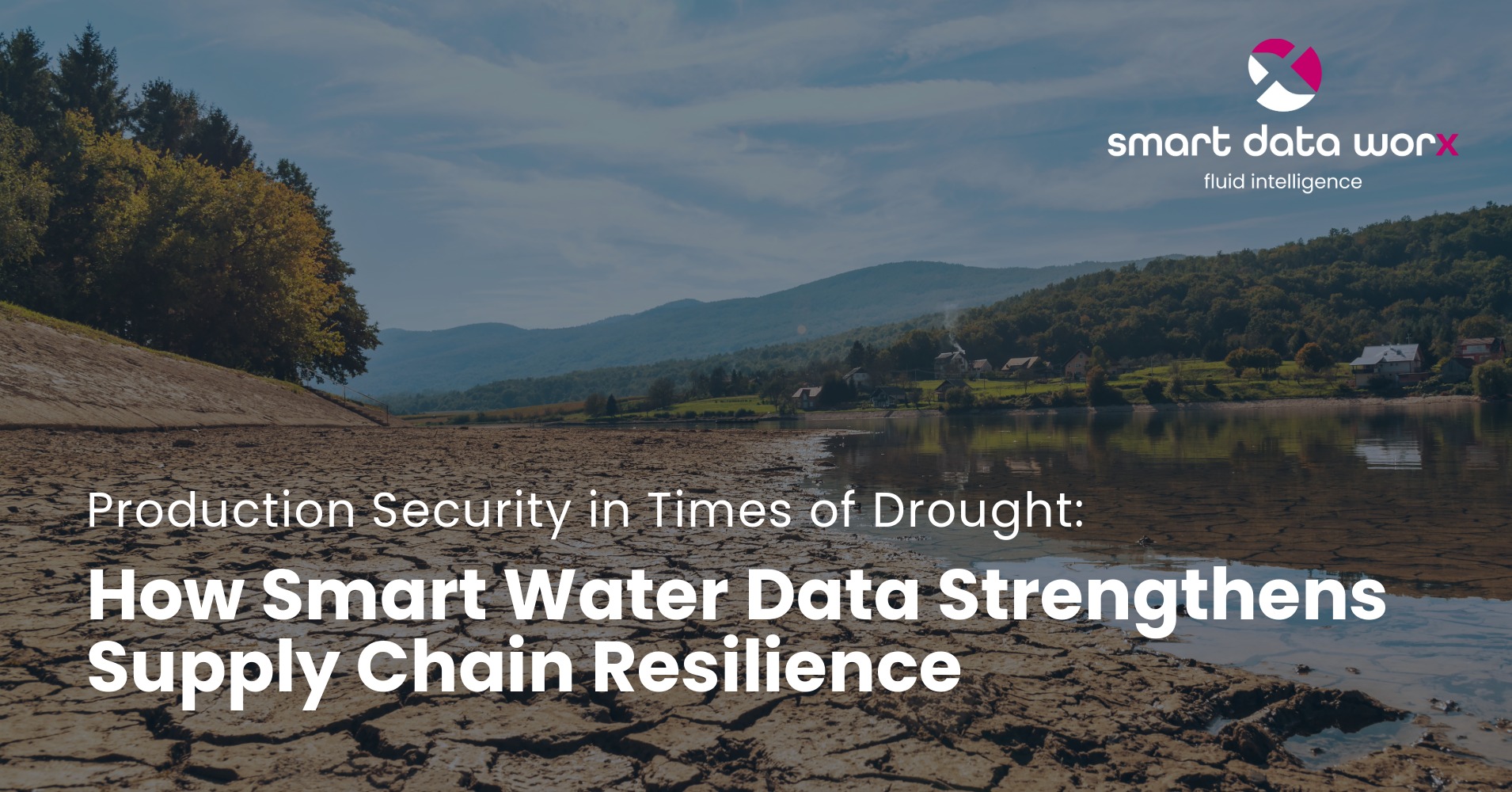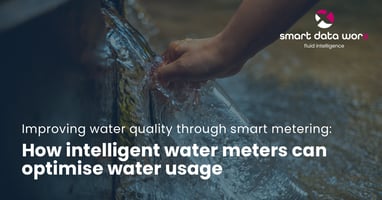Drilling data is essential for describing and evaluating the subsurface – in geology, hydrogeology...
Production security during droughts: How water data makes supply chains more resilient

In a world increasingly shaped by climate change, two issues are becoming dramatically more relevant for industrial companies: water resources and supply chain security. Whereas droughts used to be rare exceptions, they are now a regular risk. This poses serious challenges for manufacturing companies, especially those in water-intensive industries: limited water availability, disruptions in supply and the threat of production stoppages.
The challenge: droughts and supply chains
Extreme droughts are no longer exceptional occurrences, but are becoming a structural risk for industry. What used to be isolated regional water shortages has now become a global phenomenon that affects production networks, procurement and logistics alike. The stability of industrial value creation is therefore increasingly dependent on the ability to understand and manage water availability as a strategic factor throughout the entire supply chain.
Water availability as a critical factor
Droughts directly affect production processes – for example, through a lack of cooling, process or cleaning water – and indirectly through suppliers whose raw material extraction, energy supply or transport infrastructure is dependent on water. Water is an indispensable component of almost every production step, particularly in energy-intensive or chemical industries – from raw material extraction to intermediate products and final manufacturing. If this resource becomes scarce, not only individual plants come under pressure, but entire production chains.
In addition, legal requirements in many regions are restricting access to water resources. Authorities are increasingly limiting the extraction of surface water and groundwater, while competition between industry, agriculture and municipal supply is growing. These factors mean that companies can no longer view their water use as just an operational metric, but as a strategic risk – comparable to energy prices or supply bottlenecks. Those who know and understand their water data can take early action to secure production, supply and quality.
Supply chain as a networked risk
Today, production reliability means not only functioning machines, but also stable suppliers, logistics, raw materials, energy – and water. In a globalised economy, supply chains are finely balanced networks in which a disruption at one point can immediately affect other areas. If a supplier is located in a water-scarce region, a regional drought can quickly lead to bottlenecks, quality losses or price increases along the entire value chain.
What is particularly critical is that these dependencies often remain invisible. Many companies have limited transparency about the second or third tier of suppliers – where water scarcity often strikes first. The failure of a single component can bring entire production lines to a standstill. At the same time, rising transport costs or water-related energy shortages lead to indirect effects that result in delivery delays or margin losses.
It is therefore becoming increasingly necessary to link water data and supply chain information. This is the only way to identify critical locations, quantify risks and develop scenarios that highlight alternatives. In the future, a resilient supply chain will not only be digital and efficient – it will also be water-conscious.
Water data + supply chain = resilience
Combining high-resolution water data with supply chain information offers decisive advantages:- Early warning systems: Impending water shortages can be identified at an early stage – both in-house and at suppliers.
- Scenario analyses: Companies can simulate how periods of drought will affect locations and suppliers.
- Resilience optimisation: Data-based transparency makes it possible to relocate processes, adjust inventories or activate alternative suppliers.
Die Rolle von smart data worx – Wasserdaten intelligent nutzen
Modern water management systems increasingly rely on a combination of IoT technologies, geoinformation, climate data and hydrological models to make water resources transparent across entire supply chains and identify risks at an early stage. The aim is to create a data-based understanding of how water availability, site conditions and production processes are interlinked.
Technological basis
IoT sensors collect real-time measurements such as water levels, flow rates, moisture content and groundwater conditions. This data is combined with external sources – such as meteorological information, satellite data and regional water statistics – to create an accurate picture of the current and future water situation.
Based on this data, AI models and machine learning recognise patterns and trends, predict periods of drought or water stress, and report anomalies at an early stage. In addition, geo-intelligence methods and digital twins are used to virtually map hydrological systems, catchment areas, and infrastructures. This allows complex relationships between water resources, production sites, and supply chains to be simulated and better understood.
Finally, a central data space bundles all relevant information – from local sensor data to global supply chain parameters – and makes it available in a uniform, evaluable structure. This creates a reliable basis for decision-making on strategic and operational measures.
Application to supply chain risks
- Location screening: Production and supplier locations can be assessed according to water stress, drought risk and infrastructure quality.
- Real-time monitoring: Continuous observation of critical regions allows early warning systems to be established that respond to changes in water availability.
- Scenario simulation: Various drought or bottleneck scenarios can be played out to develop alternative procurement or production strategies.
- Integration into production planning: Water-related data is incorporated into resource and production decisions in order to flexibly control water-intensive processes and avoid failures.
This creates a holistic approach in which water data is not viewed in isolation but is embedded in operational decision-making processes. Companies that make targeted use of this information can reduce risks along the entire supply chain, increase resource efficiency and secure their production reliability in the long term.
Practical examples and areas of action
How can the combination of water data and supply chain management be implemented in practice? Companies from different industries face similar challenges – but the ways to ensure production security in times of growing water scarcity differ. The following examples show how data-driven water intelligence is becoming a decisive competitive factor and how organisations can build real resilience through precise monitoring, forecasting and strategic planning.
Example 1: Production with high water demand
A manufacturer of stainless steel components uses large quantities of process and cooling water. In a region prone to recurring droughts, authorities regularly restrict water extraction. With the help of intelligent water data analysis, the company identifies potential restrictions in good time and relocates part of its production to regions with stable water supplies.
Example 2: Agriculture-dependent supply chain
A packaging manufacturer sources raw materials from arid growing regions. By monitoring soil and groundwater levels, falling levels are detected early. The company responds proactively, diversifies its supplier base and avoids bottlenecks.
Areas of action for companies:
- Mapping the supply chain: Identifying water-dependent locations and suppliers.
- Data integration: Linking water, location and production data.
- Risk assessment: Evaluation of water stress, drought frequency and infrastructure quality.
- Proactive planning: Development of scenarios for different drought scenarios.
- Monitoring and early warning: Implementation of systems that automatically report water anomalies.
- Communication: Making water risks along the supply chain transparent and defining responsibilities.
Why act now?
The pressure to actively manage water risks is growing noticeably – not only for environmental reasons, but increasingly also for economic and regulatory reasons. Whereas water availability used to be taken for granted, it is now becoming a competitive factor. Companies that adopt data-based strategies in good time are not only securing their production, but also their reputation, compliance and future viability. Three developments are particularly reinforcing this pressure to act:
1. Increase in extreme weather events
Droughts, heat waves and low water levels are occurring more frequently and intensely than ever before. Regions that were previously considered water-stable are suddenly facing massive supply bottlenecks. Low water levels in rivers are hampering transport, a shortage of cooling water is forcing power plants to reduce output, and parched soils are affecting agricultural yields. These events have immediate economic consequences – from production interruptions and rising raw material prices to damage to image and loss of confidence.
For companies, this means that water availability must be anchored in risk and crisis plans as a systemically important factor in the future. Only those who respond to changes in good time can guarantee flexibility and security of supply.
2. Vulnerable supply chains
Globalisation has made supply chains efficient, but also vulnerable. Many production networks rely on a few central supplier regions – often in water-critical areas. If droughts occur there or local water restrictions are imposed, this can destabilise the entire production chain.
In addition, there is often a lack of transparency regarding the second or third tier of suppliers. Water stress or shortages among upstream partners often only become apparent when deliveries fail to arrive.
Systematic water risk management along the entire value chain – based on real-time data, geographical analyses and scenario simulations – is therefore no longer an option, but a necessity. Companies that view their supply chain from this perspective gain crucial response time and can actively manage alternative procurement or production channels.
3. Regulatory pressure and social expectations
With the growing importance of sustainability goals and ESG (environmental, social, governance) criteria, water consumption, resource efficiency and environmental impact are becoming increasingly important issues for regulatory authorities, investors and the public.
Legal requirements such as the EU taxonomy or the Supply Chain Due Diligence Act increasingly demand transparent reporting of environmental risks – including how water scarcity is being addressed. At the same time, customers and stakeholders expect credible evidence of sustainable practices.
Companies that recognise water as a strategic issue and actively manage their data gain clear advantages: they meet regulatory requirements, improve their sustainability performance and position themselves as responsible players in an increasingly sensitive market environment.
Conclusion
Water is no longer a marginal issue, but a key factor in production security. The combination of water data and supply chain information creates the basis for resilient and sustainable production systems.
With its expertise in intelligent water data management, smart data worx supports companies in identifying risks at an early stage, using resources efficiently and keeping production processes stable even in times of drought. Investing in data-based water security today secures a clear competitive advantage tomorrow.


